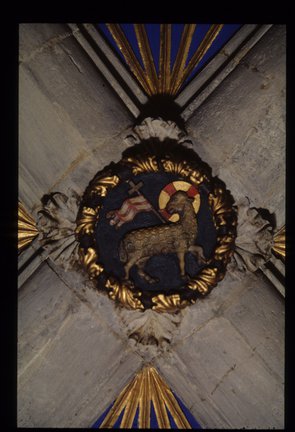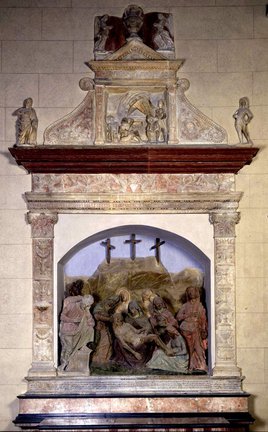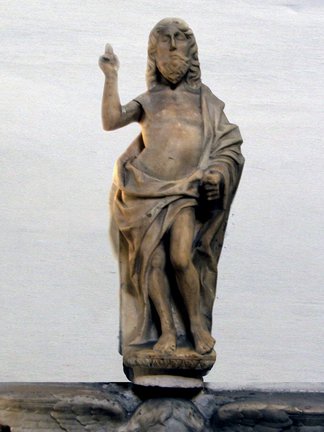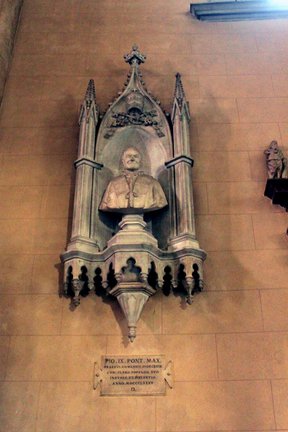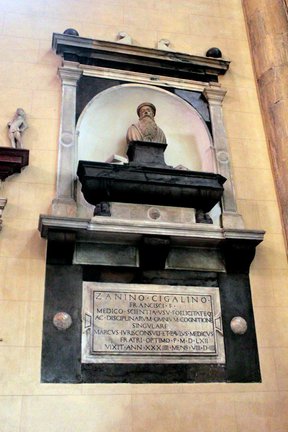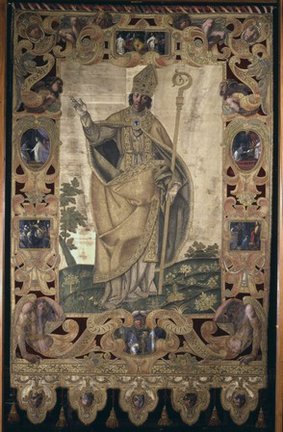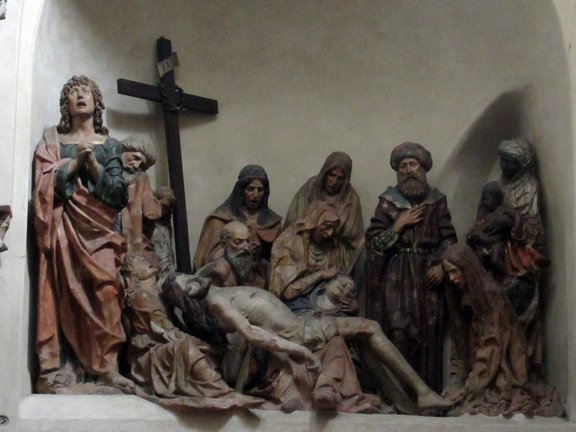Campata sinistra 5
Nella chiave di volta è scolpito l’Agnello mistico , emblema del sacrificio di Cristo ed attributo iconografico di S. Giovanni Battista cui la cappella è dedicata insieme a S. Nicola. Fu l’arciprete del Duomo Battista Bossi nel 1498 a commissionare per l’altare il gruppo del Compianto scolpito in pietra arenaria e dipinto, opera di Tommaso Rodari, come si legge nell’iscrizione sulla predella.
Il gruppo in nicchia è inquadrato da una cornice architettonica in marmo di Musso che riprende le linee di un famoso edificio rinascimentale: la facciata fiorentina di S. Maria Novella di Leon Battista Alberti. Il gusto decorativo è però tipico del rinascimento lombardo dei Rodari (lesene decorate a candelabra, fregi grotteschi, statuette alla sommità).
Il rilievo nel riquadro della cimasa presenta due soldati al sepolcro di Cristo risorto la cui immagine è scomparsa: doveva stare alla sommità oltre i due angeli. Probabilmente la statua fu rimossa quando si restaurò la parete ammalorata dall’umidità e fu collocata nella Sagrestia dei Mansionari sopra il lavabo, ora nel Museo del Duomo .
Sulla parete a sinistra sta il Busto di papa Pio IX, opera d’ispirazione neogotica di Giuseppe Bayer del 1885 . Sulla destra è il monumento funebre dedicato al medico Zanino Cigalini figlio di Francesco, opera del 1562 . Il medico morì a 34 anni: malgrado la lunga barba sono giovanili i lineamenti del busto del defunto che si erge tra pigne di libri, sopra il sarcofago inquadrato da un arco trionfale secondo la moda umanistica. La sottostante dedica dei fratelli Marco, giurista, e Paolo, medico, rende onore alla vasta cultura del medico comasco.
Lo stendardo del Morazzone (1608? – 1609) , parte ricamato, parte dipinto a olio, raffigura da una parte il patrono S. Abbondio con episodi della sua vita nei medaglioni; dall’altra angeli in adorazione dell’Eucarestia e temi connessi nei medaglioni, perché fu commissionato dalla confraternita detta Compagnia del Ss. Sacramento.
La cappella di S. Giovanni Battista fu eretta in adempimento delle disposizioni testamentarie del vescovo di Como Francesco Bossi (1420-1434) ed era di patronato della sua famiglia.
Il gruppo scolpito sopra l’altare dal Rodari è affine ai numerosi compianti padani che sono però in legno o in terracotta e rivela suggestioni sia da quello di Agostino De Fondulis in S. Satiro a Milano, sia dal Bramante .
Nella soprastante parete durante la sistemazione degli intonaci in previsione della dipintura delle volte e delle pareti si ritrovò nel 1839 la sepoltura di un personaggio ridotto a scheletro, ma ancor tutto vestito di color “ponceau” (rosso scuro), se ne erano conservati ancora i capelli e la barba. Il colore della stoffa farebbe pensare a un canonico del duomo. Quella salma fu nuovamente rinchiusa nella parete settentrionale del duomo, non lontano dalla parte di muro dove stava il Cristo risorto. Nella sistemazione si spostò all’indietro la parte più alta dell’ancona marmorea inclinando verso la parete la parta più alta dell’ancona e togliendo la statua di Cristo risorto ora in Museo.
Nella dedica del busto di papa Pio IX fatta dal vescovo Pietro Carsana con il suo clero e il suo popolo “insubre et helvetio”, questa precisazione sul popolo svizzero suona come una rivendicazione sulla parte di diocesi ticinese separata da quella comasca nel 1871, poco prima dell’ingresso dello stesso vescovo.
